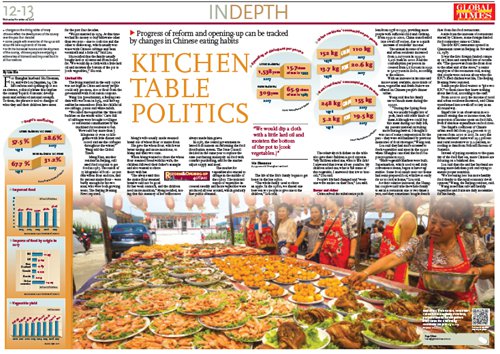○ Changes on the dining tables of many Chinese reflect the development of the country over the past four decades
○ Some people with memories of the 1970s talk about the bare cupboards of the era
○ With the increased income and development of the country, Chinese people are enjoying a wide variety of domestic and imported food in all four seasons
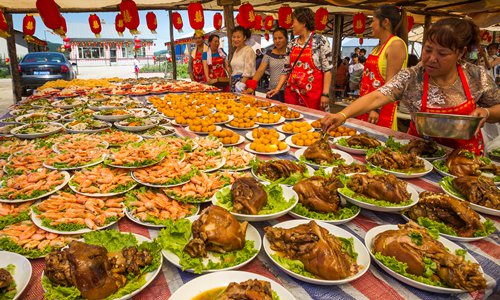
Residents from Raohe, Northeast China's Heilongjiang Province, prepare dishes for neighbors who came for a wedding ceremony on July 15, 2017.Photo: VCG
For Shanghai husband Hu Shennan, 75, and wife Lou Jingnian, 74, China's reform and opening-up is not an abstract, political phrase that implies the country's quick economic development and enhanced national strength. To them, the phrase is tied to changes of what they and their children have eaten for the past four decades.
"We got married in 1974. At that time we had no money to buy tableware other than two pots - one to cook rice and the other to make soup, which usually was water with Chinese cabbage and bean vermicelli and a little oil," said Lou.
Hu recalled that the family usually bought lard or oil extracted from boiled fat. "We would dip a cloth with a little lard oil and moisten the bottom of the pot to [cook vegetables,]" Hu said.
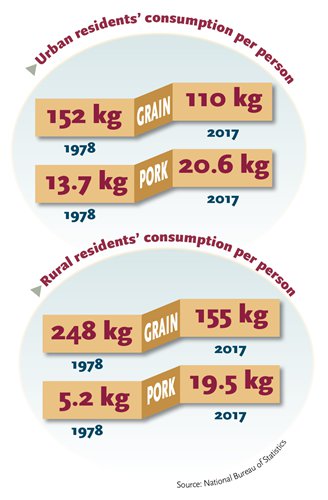
Graphic: Global Times
Limited life
The living standard in the early 1970s was not high in China and many people could only get meat, rice or flour from the government with food ration coupons.
Wang Lin (pseudonym), a Beijing resident who was born in 1974, said the vegetables he remembers from his childhood are cabbage, potato and white radish.
"We called the vegetables the 'three old buddies on the winter table.' Carts full of cabbages were brought to villages or residential communities by the truckload for residents to buy. We would buy more than 5 kilograms or even 50 kilograms with little money and stored and ate the cabbages throughout the winter," Wang told the Global Times.
Meng Xian, another resident in Beijing, still used food coupons to get food in 1985. The ration of 55 kilograms of food - 20 percent wheat flour and rice, and 80 percent maize flour - were barely enough for his two sons, who were both growing teens, The Beijing Evening News reported.
Meng's wife usually made steamed bread out of wheat flour or maize flour.
She gave the wheat flour, which was better tasting and more nutritious, to Meng and their two sons.
When Meng wanted to share the wheat flour steamed bread with his wife, the children followed their father's example and also wanted to share theirs with her.
"She always said that the maize flour steamed bread would not be good for her weak stomach, and the children need more nutrition," Meng recalled, noting that this memory of her selflessness always made him grieve.
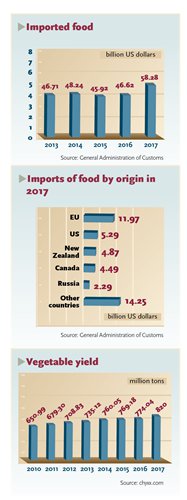
Graphic: Global Times
In 1985, the central government released a document on reforming the food distribution system. The State Council decided in the same year to replace the state purchasing monopoly on food with contract purchasing, and let the market adjust supply and need.
The market for vegetables also started to change in the middle of the 1980s. The national output of vegetables increased steadily and more vegetables were produced all year around, which gradually met public demand.
The life of the Hu's family began to get better in the late 1980s.
"The whole family used to share an apple. In the 1980s, we shared one between two people or give one to the children," Lou said.
The relatively rich dishes on the table also gave their children a good appetite. "My children asked me, what is this fish? I answered that it was silvery pomfret. My children asked me, what is the name of this vegetable, I answered that it was broccoli," Lou said.
People's life had changed and "everyone wore smiles on their face," Lou said.
Better and richer
China solved the subsistence problem from 1978 to 1991, providing more people with sufficient food and clothing. From 1992 to 2000, China transformed into a well-off society, due to a quick increase of residents' income.
The annual income of rural and urban residents increased from 2,027 yuan in 1992 to 6,256 yuan in 2000. And the consumption per person increased from 1,672 yuan in 1992 to 5,027 yuan in 2000, according to the release.
With an increase in income and more variety available, more kinds of meat, vegetables and fresh fruits were offered on Chinese people's dinner tables.
Wang said that his family ate too much meat during the 1990s.
"During the Spring Festival, we usually bought lots of pork, lamb and other kinds of meat. Although we could buy this meat during our daily life, my parents insisted on buying more during festival. I thought it was out of some compensation for the past - they were still haunted by previous memories of food shortages," Wang said.
Lou said they had more accesses to fresh vegetables and meat in the 1990s when Shanghai cancelled the food coupon program in 1993.

Graphic: Global Times
"More vegetable markets were built. Supermarkets, which used to sell daily convenience items, began to have vegetables. Some food stands near our home had semi-prepared food, which was easily for us to cook at home," Lou said.
As their salaries increased, the Shanghai couple would take the whole family to eat in a restaurant one or two times a year, and they sometimes bought french fries from fast food restaurants.
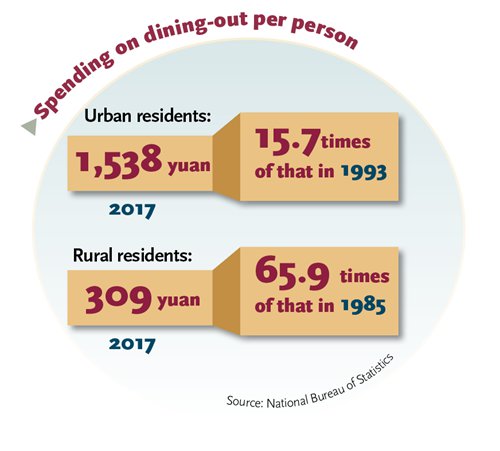
Graphic: Global Times
Aside from the increase of restaurants started by Chinese, some foreign-funded food companies came to China.
The first KFC restaurant opened in Qianmenxi street in Beijing on November 12, 1987.
It was the first foreign-funded company in China and attracted lots of customers. "The queue was from the front door to the other end of the street," a senior employee of the restaurant said, noting that people were curious about what the KFC's fried chicken was like, The Beijing Evening News reported.
Some people asked waiters to "give two KFC" to them since they knew nothing about fast food, according to the staff.
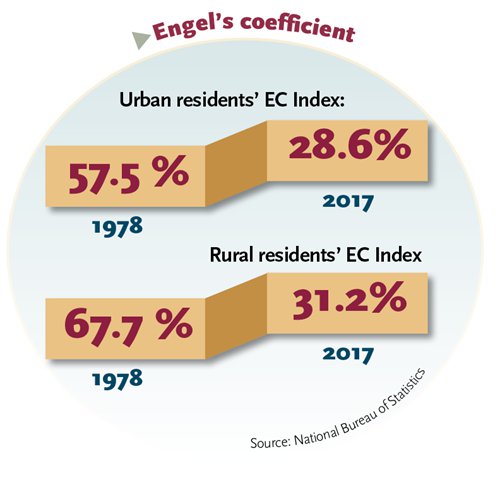
Graphic: Global Times
From 2001 to 2017, the income of rural and urban residents increased, and China transformed into a well-off society in an all-round way.
Engel's law is an observation in economics stating that as income rises, the proportion of income spent on food falls, even if absolute expenditure on food rises.
The Engel's coefficient of China's urban areas fell from 39.4 percent to 35 percent from 2000 to 2013. In 2017, the urban residents' index was 29.3 percent and rural residents was 31.2 percent, according to data from National Bureau of Statistics.
Instead of paying attention to the quantity of the food they eat, more Chinese are focusing on a balanced diet.
Lou said that she and her husband are eating more fish than pork and trying to ensure proper nutrition.
"We are eating less but more healthy food thanks to the rapid economic development," Wang, the Beijing resident, said.
Wang noted that safe and healthy vegetables and fruits are daily necessities for his family.
